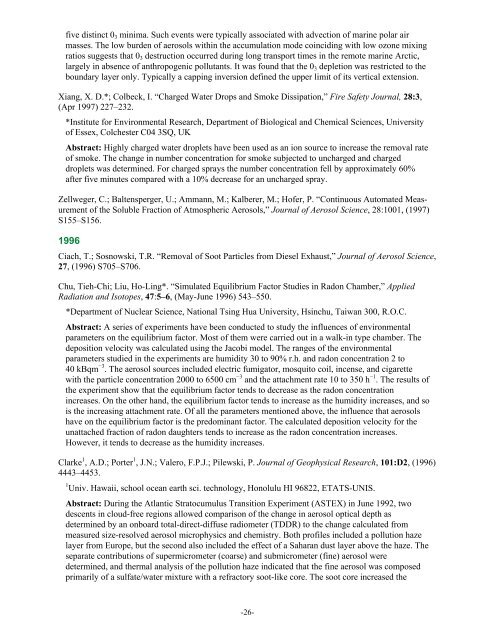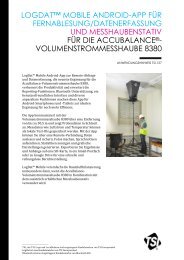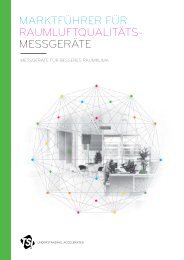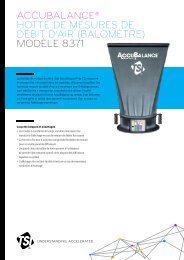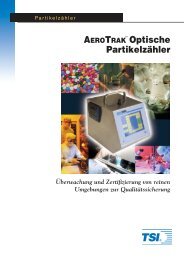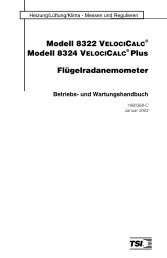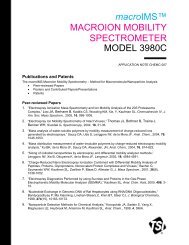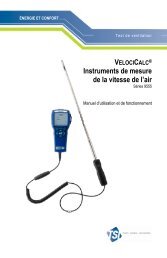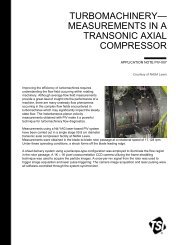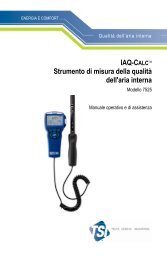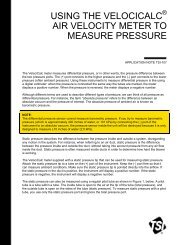Model 3340 Laser Aerosol Spectrometer Bibliography - Tsi
Model 3340 Laser Aerosol Spectrometer Bibliography - Tsi
Model 3340 Laser Aerosol Spectrometer Bibliography - Tsi
You also want an ePaper? Increase the reach of your titles
YUMPU automatically turns print PDFs into web optimized ePapers that Google loves.
five distinct 03 minima. Such events were typically associated with advection of marine polar air<br />
masses. The low burden of aerosols within the accumulation mode coinciding with low ozone mixing<br />
ratios suggests that 03 destruction occurred during long transport times in the remote marine Arctic,<br />
largely in absence of anthropogenic pollutants. It was found that the 03 depletion was restricted to the<br />
boundary layer only. Typically a capping inversion defined the upper limit of its vertical extension.<br />
Xiang, X. D.*; Colbeck, I. “Charged Water Drops and Smoke Dissipation,” Fire Safety Journal, 28:3,<br />
(Apr 1997) 227–232.<br />
*Institute for Environmental Research, Department of Biological and Chemical Sciences, University<br />
of Essex, Colchester C04 3SQ, UK<br />
Abstract: Highly charged water droplets have been used as an ion source to increase the removal rate<br />
of smoke. The change in number concentration for smoke subjected to uncharged and charged<br />
droplets was determined. For charged sprays the number concentration fell by approximately 60%<br />
after five minutes compared with a 10% decrease for an uncharged spray.<br />
Zellweger, C.; Baltensperger, U.; Ammann, M.; Kalberer, M.; Hofer, P. “Continuous Automated Measurement<br />
of the Soluble Fraction of Atmospheric <strong>Aerosol</strong>s,” Journal of <strong>Aerosol</strong> Science, 28:1001, (1997)<br />
S155–S156.<br />
1996<br />
Ciach, T.; Sosnowski, T.R. “Removal of Soot Particles from Diesel Exhaust,” Journal of <strong>Aerosol</strong> Science,<br />
27, (1996) S705–S706.<br />
Chu, Tieh-Chi; Liu, Ho-Ling*. “Simulated Equilibrium Factor Studies in Radon Chamber,” Applied<br />
Radiation and Isotopes, 47:5–6, (May-June 1996) 543–550.<br />
*Department of Nuclear Science, National <strong>Tsi</strong>ng Hua University, Hsinchu, Taiwan 300, R.O.C.<br />
Abstract: A series of experiments have been conducted to study the influences of environmental<br />
parameters on the equilibrium factor. Most of them were carried out in a walk-in type chamber. The<br />
deposition velocity was calculated using the Jacobi model. The ranges of the environmental<br />
parameters studied in the experiments are humidity 30 to 90% r.h. and radon concentration 2 to<br />
40 kBqm −3 . The aerosol sources included electric fumigator, mosquito coil, incense, and cigarette<br />
with the particle concentration 2000 to 6500 cm −3 and the attachment rate 10 to 350 h −1 . The results of<br />
the experiment show that the equilibrium factor tends to decrease as the radon concentration<br />
increases. On the other hand, the equilibrium factor tends to increase as the humidity increases, and so<br />
is the increasing attachment rate. Of all the parameters mentioned above, the influence that aerosols<br />
have on the equilibrium factor is the predominant factor. The calculated deposition velocity for the<br />
unattached fraction of radon daughters tends to increase as the radon concentration increases.<br />
However, it tends to decrease as the humidity increases.<br />
Clarke 1 , A.D.; Porter 1 , J.N.; Valero, F.P.J.; Pilewski, P. Journal of Geophysical Research, 101:D2, (1996)<br />
4443–4453.<br />
1<br />
Univ. Hawaii, school ocean earth sci. technology, Honolulu HI 96822, ETATS-UNIS.<br />
Abstract: During the Atlantic Stratocumulus Transition Experiment (ASTEX) in June 1992, two<br />
descents in cloud-free regions allowed comparison of the change in aerosol optical depth as<br />
determined by an onboard total-direct-diffuse radiometer (TDDR) to the change calculated from<br />
measured size-resolved aerosol microphysics and chemistry. Both profiles included a pollution haze<br />
layer from Europe, but the second also included the effect of a Saharan dust layer above the haze. The<br />
separate contributions of supermicrometer (coarse) and submicrometer (fine) aerosol were<br />
determined, and thermal analysis of the pollution haze indicated that the fine aerosol was composed<br />
primarily of a sulfate/water mixture with a refractory soot-like core. The soot core increased the<br />
-26-


